Content
Downloads
Ongoing Research & Envisioning
Overview
The journey of sustaining a paradigm shift in education should be always evolving. At no point will a model be created which is definitive and final. As society, technology and opportunities change, so too does envisioning in terms of research and practice into how learning best works.
Any coalition that actively seeks to develop ‘best practices’ in learning must envision and draw from existing research and diverse examples from across cultures and societies. A clear vision - crucial to steering any organisation - must be supported by research and developed collectively to unite a community.
Envisioning is an inherently grassroots process and needs agility to empower further vision, ideation and research. A shared envisioning process in a learning community enables individual passion to unite with other like-minded individuals and, in so doing, creates momentum. Shared passion can evolve into a definitive collective viewpoint, based upon accepted research, underpinning the pedagogic direction for a school community.
When research-based vision becomes part of the culture, it fosters action. Vision, supported by research, gives licence for early innovators to be adventurous by growing a culture of permission and provides confidence to try new ideas.
Executive Summary
The journey of sustaining a paradigm shift in education should be envisioned to always be evolving. There will never be a point where a model is created that is definitive and final. Therefore, learning models must remain agile and supported by appropriate ongoing research and envisioning.
The best learning experiences should draw from existing research and diverse examples from across cultures and societies. Strong research supports community vision, validates decisions and actions, and is crucial to helping sustain a paradigm shift.
Learning innovation founded on solid research has strength because it supports all decisions and actions. Advances in neuroscience research, for example, illuminates aspects of brain functioning that were previously not understood. This research alone provides a better understanding of the science behind learning; a vital component learners should be made aware of.
Research must support and inspire a collective envisioning process for any learning community. A clear vision statement can emerge from research which supports all learning, regardless of the cultural context. Research-supported vision enables educational innovators to be adventurous by providing them with the confidence to try new ideas.
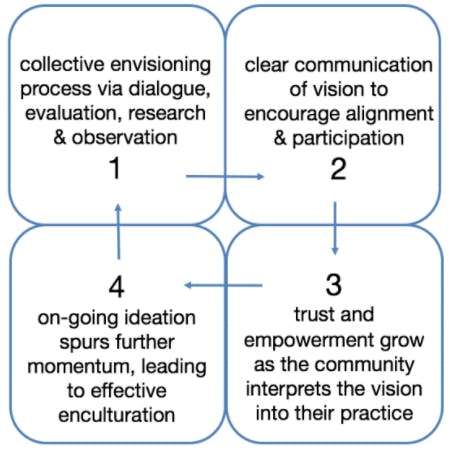
The journey of envisioning and implementing a new paradigm requires continued agility to refresh, ideate and research. If the vision has sufficient strength, clarity and ownership among the community, it can provide the momentum to see sustained and embedded change which will enhance pedagogic direction, organisational culture and professional practices.
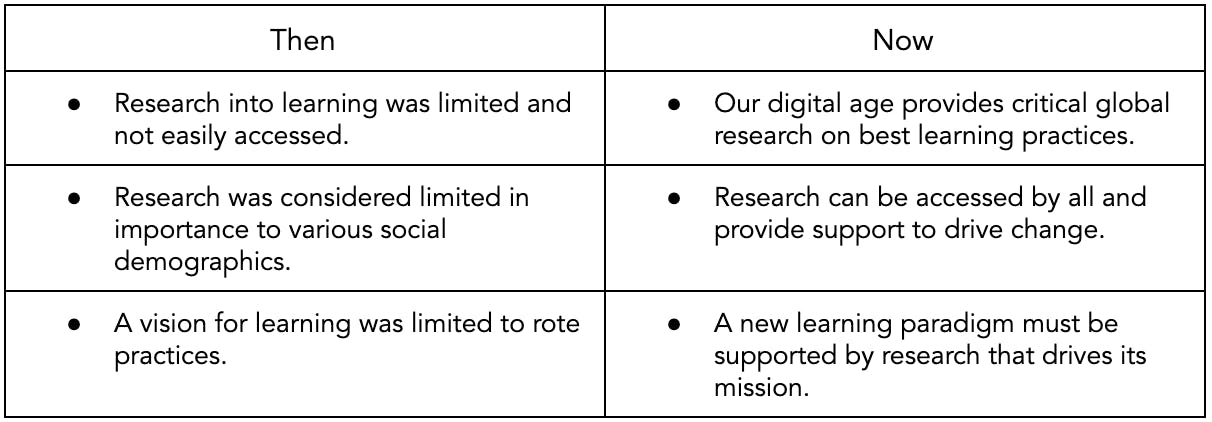
Starting Questions
- Does the learning community use research to inform its decisions?
- Does the vision or mission statement of the learning community require research to validate it?
- How often does the learning community reflect on its own vision statement? When was the last time it was revised?
- Do pedagogical practices form part of the vision?
- Is research used to support and drive any of the learning experiences of the community?
Key Initial Actions
- Set up a research team that will guide the learning culture by disseminating valuable information that will establish a clear vision for learning and key practices.
- The research team should reach community-wide actors who will help support decision-making and guide the learning community vision. This might include links to online communities.
- Be thorough in the research. This is a crucial part of establishing a strong vision for learning. The more thorough, the more informed the learning community will be and more likely to create a strong, influential learning culture.
On-going Actions
- Look outside your own cultural context to observe innovative learning practices happening elsewhere. Iterate how these might be appropriate to your learning context.
- Be willing to adapt to remain relevant to changes occurring in education and elsewhere, in particular global work trends. Ultimately your learning community should empower all its learners to emerge as confident individuals, ready to immerse themselves with future-ready skills.
- Put theory into practice by continuing to research up to date learning methods that can update the learning community's pedagogic designs.
- Share information with the whole learning community. This validates the reasons behind decisions taken and enables full transparency, which can strengthen communication and collaboration.
Find out more
The journey of sustaining a paradigm shift in education should be always evolving. At no point will a model be created that is definitive and final. While an initial vision might provide the necessary momentum for change, the rapid shifts in culture and societies will demand an ongoing envisioning process. No one should ever reach a conclusion that they have arrived at a fixed place of change. The journey of change requires continuous revisiting, reshaping and resetting of vision. It is an integral part of the process. An on-going and collective envisioning process has the potential to support the process of sustaining educational change and any resultant paradigm shift.
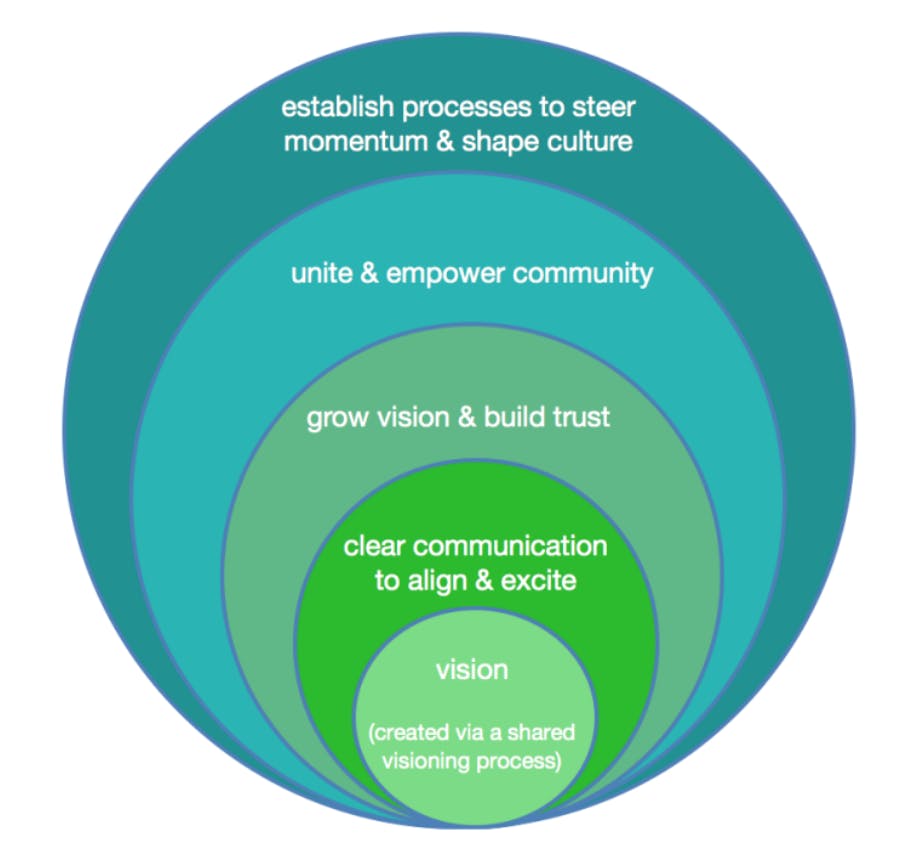
Research processes are likewise fluid. Innovation that is envisioned and founded on recognised research will have a strength that arises simply because of the recognition of the validity of the research. In an education context, this means that any learning community that continually draws from research will be able to reference the legitimacy of approaches, especially in communities that might have a tendency to revert to previous practices. If a new learning paradigm is to establish itself, it must provide the necessary evidence to support its principles. Research must include a focus on cognitive neuroscience, psychology and learning.
As a community focuses on developing a collective educational vision and direction for itself, it is this combination of ‘blue sky thinking’ matched with an awareness of sound research into how learning works - the science of learning - that will support sustained change.
At Learnlife, the emphasis on evidence-based best practice, grounded firmly towards achieving the goal of independent, self-determined learning (heutagogy), all the while striving toward a transdisciplinary perspective, should provide the necessary foundations, understandings and justification for new ways of conceiving and facilitating learning, regardless of the context.
Key Ideas
- Vision should never be static - collective envisioning needs to be a dynamic process that constantly evolves supporting any change processes.
- Research is vital in an educational change process. It can support vision, underpin actions and help create a pathway, sustaining any paradigm shift.
- Research must be diverse and include examples of learning that span cultures and societies.
- Research must inspire a vision that can be achieved through action.
-
Vision should never be static - collective envisioning needs to be a dynamic process that constantly evolves supporting any change processes.
Vision – or more specifically, a shared visioning process, is recognised by many organisational change theorists, to be the key to igniting and sustaining deep change. If a vision has sufficient strength, clarity and ownership among the community, then it will provide the momentum to see sustained and embedded change.
The following statements help identify the importance of vision, and a collective envisioning process, to establishing and sustaining the direction of educational change:
Statement no. 1
Vision arising out of a visioning process is a clarifier, it has strength. If the vision has been developed through a collective process, that vision can unite the community. Visioning is an inherently grassroots process and needs to be allowed to empower further vision and ideation.
Statement no. 2
Vision is collectively drawn from the professional passion of individuals. A shared visioning process in a school context enables individual passion to unite with other like-minded individuals, and in so doing become stronger. The shared passion evolves into a definitive collective viewpoint, underpinning the pedagogic direction for the school community. Vision in an educational context is therefore inherently about team and collaboration. Because the vision is school-based, not imposed externally, it has immediate momentum.
Statement no. 3
By its very premise, vision involves change; it describes an envisioned future.
Statement no. 4
Vision guides decision-making at a micro level and provides direction at a macro level. Vision inspires growth and action follows vision.
Statement no. 5
A shared visioning process instigates educational change by empowering the community to grow the vision through an aligned understanding. Shared visioning also creates momentum, which in turn fuels vision. Shared vision develops trust and creates an environment where there is permission to ‘fail forward’.
Statement no. 6
Vision creates a context for a shared and visible language of learning. In an educational setting, vision creates the premise for a school-wide pedagogical approach.
Statement no. 7
Vision aligns resourcing around a clear goal. Vision creates the context where collaboration is necessary to attain goals and helps sharpen thinking to a specific focus.
Statement no. 8
When vision becomes part of the culture, it fosters action. Vision gives licence for early innovators to be adventurous by growing a culture of permission, and provides the confidence needed to try different ideas. Vision places an emphasis on valuing people as they enact the vision.
Statement no. 9
A visioning process broadcasts a clear model and structure for change. Because shared vision is by its very nature co-created, vision develops leadership capacity by valuing group-based observation, research and reflection as a means to grow. The act of visioning encourages creativity and develops the capacity of teachers to use space in new ways.
Statement no. 10
Envisioning creates the dynamic where a guiding coalition of change agents can emerge. Once visible, vision also tends to attract external interest whereby networks grow.
Vision inspires growth and action follows vision. ‘Vision is seen to be a powerful agent of change, providing direction and uniting people around a common goal and as a result, unleashing the energy needed to drive educational change. By engaging in a shared visioning process, different processes and structures are established to show ‘how’ vision generates change. The act of visioning itself creates the circumstance in which vision is allowed to generate change’ and ultimately to sustain and support that change.
Vision-supported change will impact multiple facets of a community. These include the pedagogic direction, the organisational culture and the professional practices. Many schools create a broad long term ‘vision’ and plan, but in many instances fail to think through the pedagogic vision that needs to support any strengthening of the learning culture.
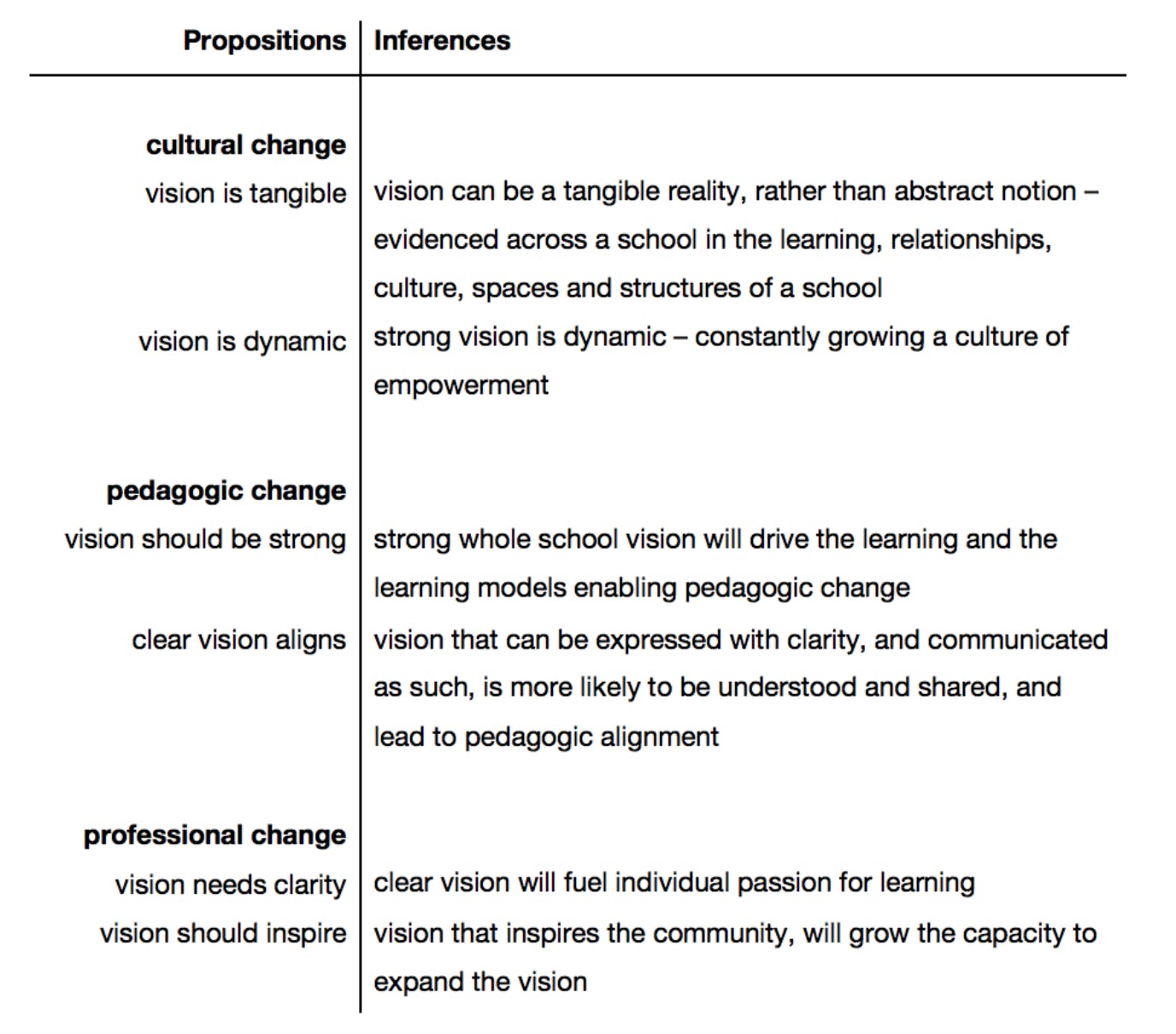
2. Research is vital in an educational change process. It can support vision, underpin actions and help create a pathway, sustaining any paradigm shift.
Traditional schooling exists in a context where there can be significant scepticism about changing the way classrooms operate. It is for this reason that it is imperative that new learning paradigms draw from recognised existing research and seek to bring new understandings about cognitive neuroscience into the conversation about appropriate learning methodologies.
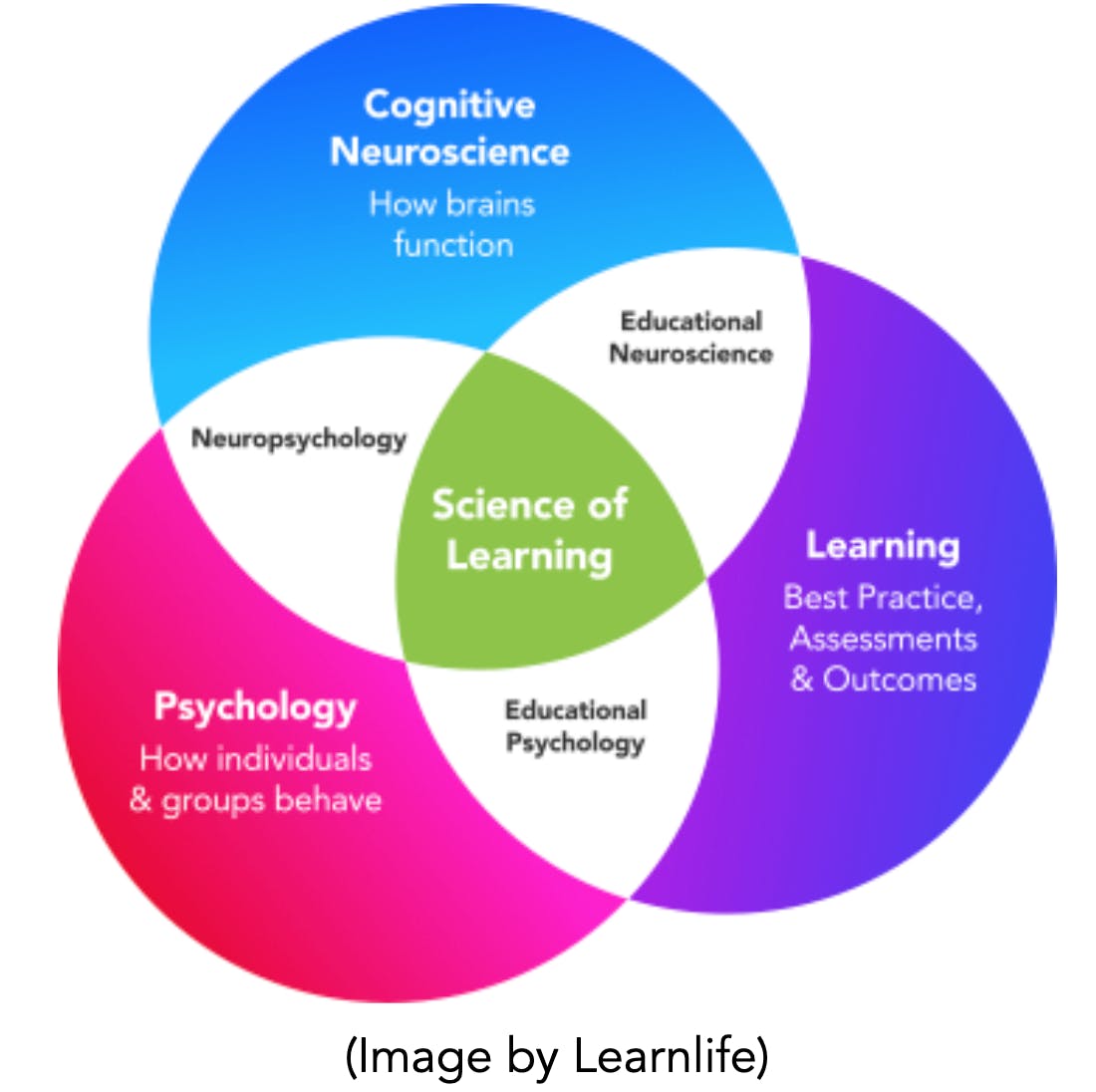 Research offers a valid narrative and tangible reasons for taking action. Hard data can support the directions for change and decision-making at both government and organisational levels. Introducing best practices, theories, new methods or learning concepts with supporting evidence increases accountability, transparency and empowers stakeholders with better opportunities to deliver and influence change. Research contributes to building and developing knowledge that can be used to aid success.
Research offers a valid narrative and tangible reasons for taking action. Hard data can support the directions for change and decision-making at both government and organisational levels. Introducing best practices, theories, new methods or learning concepts with supporting evidence increases accountability, transparency and empowers stakeholders with better opportunities to deliver and influence change. Research contributes to building and developing knowledge that can be used to aid success.
The mission of any learning community is influenced by the evidence it gathers and uses. Ongoing research is critical to sustaining new directions in learning. Advances in neuroscience are illuminating aspects of brain functioning that were previously not understood. A strong research practice and culture will help steer the directions of change within a community.
Research processes can be systematised in order to support the processes of innovation and change. The following model outlines a process that merges research, envisioning and ideation as a cycle that can drive pedagogic innovation. Models for change need to be agile, but if grounded in observation, reflection and research, have the potential to provide recurrent momentum to embedding more diverse approaches to learning methodologies and new ways of approaching learning.
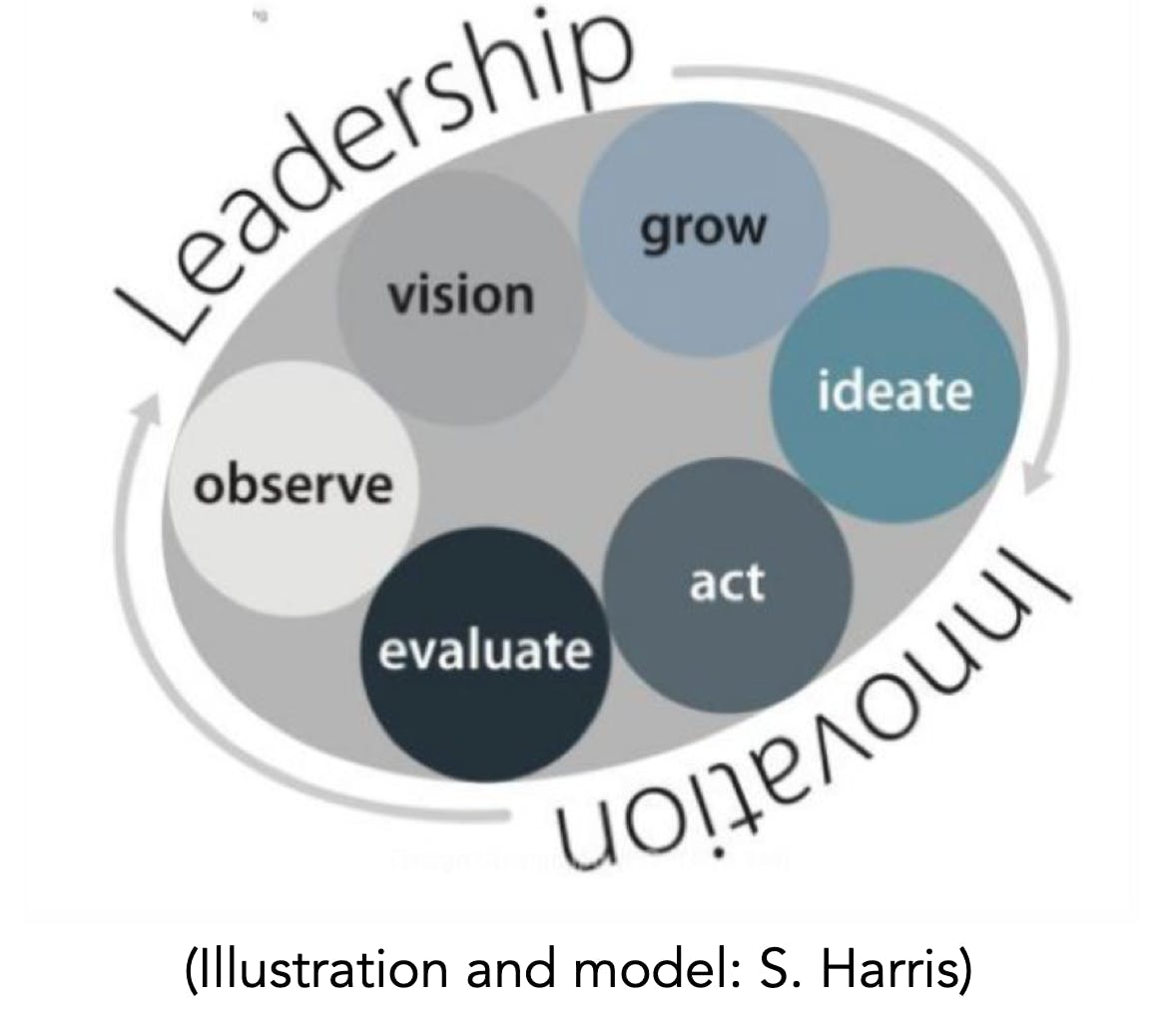 As seen above, a process of observation, investigation and research (summarised as observe) can provide the direction and impetus for a collective envisioning process. The success and strength of that collective envisioning will be evident in the tangible growth of the vision across the organisation as people interpret it into the activities of learning. Out of that should flow the ideas for energising learning in multiple forms, itself leading to definite actions and implementation. The process of reflecting on the outcomes and output arising from the implementation, itself naturally leads to evaluation and if needed, fresh research and observation.
As seen above, a process of observation, investigation and research (summarised as observe) can provide the direction and impetus for a collective envisioning process. The success and strength of that collective envisioning will be evident in the tangible growth of the vision across the organisation as people interpret it into the activities of learning. Out of that should flow the ideas for energising learning in multiple forms, itself leading to definite actions and implementation. The process of reflecting on the outcomes and output arising from the implementation, itself naturally leads to evaluation and if needed, fresh research and observation.
In any change process, it is important to revisit the underpinning research and theoretical assumptions in order to help sustain and support the change. This in turn will continually help shape the learning culture.
3. Research must be diverse and include examples of learning that span cultures and societies.
The dialogue around innovation in learning is happening on a global scale. The issues surrounding education have common elements no matter which country is involved, but at the same time have unique contexts. Issues such as teacher quality and the prevalence (and reliance) on rote learning seem to be evident all over the world. On the other hand, different countries have unique issues, perhaps relevant to the cultural or political histories.
In 2015 UNESCO, together with UNICEF, the World Bank, UNFPA, UNDP, UN Women and UNHCR organised the World Education Forum 2015 in South Korea. An outcome of this forum was a framework for action related to the implementation of the UN Sustainable Development Goal Number 4: Ensure inclusive and equitable quality education and promote lifelong learning opportunities for all.
There are signs of growing awareness of the need for an international perspective when it comes to research on educational change in particular. Researchers working on a project in 2017 for the Journal of Educational Change detected a move away from what they labelled as research predominantly focusing on the ‘anglosphere’ to emergent research that represented a more global perspective.
4. Research must inspire a vision that can be achieved through action.
As suggested, research validates the ‘why’ regarding decisions. One of the most crucial aspects of research is its capacity to inform and shape the vision and values of a learning community. Thorough, well-informed research can be used to guide vision that in turn will influence a learning culture.
Any journey of educational change is continual. There should not be a point where a community views its pedagogic approaches as complete or static, as society, culture and technologies are continuously evolving. Therefore research needs to match this and be an ongoing process providing evidence to inform decision making around key pedagogical methods in its community.
If a vision is to be fully realised and achieved, it must be shared. All stakeholders, including parents, educators, learners and leadership must form the community that is kept informed and has an influence over its vision. Asking questions, debating and offering recommendations based on information provided by research is a robust and ethical method for making shared decisions to devise any vision statement.
At Learnlife, research is materialising to devise 21 elements we believe are crucial to providing an optimum environment for learning - and it will be a continued process as new information emerges and influences change. Research has influenced the overarching vision at Learnlife, and continued research will provide the flexibility to iterate and redesign a new organisational vision as and when required.
Envisioning enables people to dream, imagine, reimagine, philosophise or ponder certain notions. It is a worthwhile endeavour and supporting ideas and opinions that stem from envisioning is necessary in an increasing fake news culture. For a new learning paradigm to emerge, it requires envisioning with research to support it.
One of humanity’s strengths lies in its intuition to search for truth and meaning, and envisioning a new learning paradigm requires high intuition. Humans have the capacity for intuition, but it remains obsolete without evidence to support it. The more research that is carried out, the deeper and stronger the envisioning that can occur. Research is essentially what puts theory into action and what drives the envisioning process to become real.
Finally - Learnlife is in the fortunate position to be able to use research to make decisions and put discovered theories and ideas into practice. This is the result of being an organisation residing outside of the influence of government systems, where change is in fact most needed. The goal at Learnlife is to use its research to inform action and influence governments and policy makers from the outside. This can only happen through the support of high quality research and evidence gathered to create frameworks for new learning relevant to the 21st century.
Act now
The overall strength of a vision is evidently perceived to be the outcome of a team approach to the development of vision. It suggests an active process whereby a team chooses to describe a new future, based on their collective understandings, experiences or observations. To a degree, it is intuitive, but also summative. Intuition about what the future might hold instigates thought processes to evaluate that intuition against career, workforce or societal predictions, and to then consider the steps necessary to bring the preferred future into reality. If this process is undertaken collectively, research suggests that any vision that is developed, recorded and communicated, will be far stronger than the vision of an individual.
Research is one of the most crucial factors to validating the integrity of a new learning paradigm. One of the failings of many organisations deemed thought disruptors or change makers is the lack of evidence they provide when explaining their decisions. No matter how valid or reasonable thoughts and decisions might be, they will not be taken seriously by those who have the power to bring about change at a systemic scale, unless evidence supports reasons.
Research is an activity that is often overlooked and taken for granted in organisations - in an information age there is no excuse for not having evidence to support reasons for action. Developing the critical thinking skills to accurately assess and judge information and its validity will remain crucial to formulating the decisions that can drive the success of a new learning paradigm and its learning communities.
The following statements should be taken into consideration if learning communities wish to embed new learning into their pedagogy and culture effectively:
- Be thorough
The more thorough and broad the research that is carried out, the higher the likelihood of its relevance. Often individuals and teams enter into research with a prediction or idea of what to expect, only to realise that during various stages, new ideas have emerged. It is crucial to avoid judgment even when research does not go as planned. A fail-forward mindset is required - failure should be seen as a stepping stone to success. - Share information
Information that is shared enables a broader perspective which can increase the quality of ideas and decisions. It allows for individuals to develop empathy around other people’s thoughts and feelings on particular subjects while opening up the forum for debate around crucial decisions to be taken. Sharing information also provides individuals with a sense of ownership over decisions made which can increase and strengthen a culture. Furthermore, the sharing of information offers a research team the opportunity to consider viewpoints that may have been overlooked in specific areas, which can further strengthen the outcomes of research. Information must be shared with all stakeholders who are directly or indirectly impacted by the learning community. - Put theory into practice
There is no point in conducting research unless the learning community is willing to put it into practice. Whether a community resides inside or outside government influence should not deter research occurring and being used to catalyse change. Using the best pedagogical practices can only increase the impact of the community whether a culture of standardisation exists or not. The only limiting factor might be the amount of freedom available to commit to using new learning practices. - Be willing to constantly adapt to remain relevant
A learning community must be willing to adapt its learning culture if they believe it is the best thing to do. In a world of constant change, communities will be required to constantly change to suit that fluid world. One of the ailments of the current, traditional learning system is that it stagnated because it did not adapt to become more relevant. Therefore, there is little point making radical changes then once this is done, believing there is no more need for change - change must always be a fluid process. - Look outside your own cultural context
One of the key factors that stymies change, is people’s ability to neglect what is happening beyond their local or national jurisdictions. Some of the most innovative learning examples are happening in the most unusual places and can serve to inspire change. Once information is gathered on groundbreaking learning communities, it can enable an envisioning process to occur within your own context.
Educational institutions are generally committed to maintaining the status quo within traditional systems and often lack the resources or fortitude to create change. It takes a brave learning community to go against the grain, but they do exist - research can reveal them! - Set up a research team
If a learning community is truly committed to delivering change, it must gather the change makers and thought disruptors within it to formulate new learning approaches. Every learning community has unique needs and a research team should support what those needs are, developing in a way that encourages continued progress.
Examples in action
The examples in action below are divided into two sections and focus on;
- research Institutes supporting learning innovation by providing educational support through professional research or consultancy, and;
- communities driving innovative learning practices using research based approaches to support the vision for their community.
Both sections are equally useful, either providing theoretical frameworks or evidence based learning outputs supported by research. Research institutes could potentially use learning communities to conduct research, and learning communities could base their vision statement and develop their learning culture from well informed research provided by specialist organisations.
The success of a learning community is in its willingness to use research to reinvent itself by creating a fresh vision statement when necessary which is likely to completely change a learning culture. Those communities willing to take a risk who are recognised as the change makers and innovators, paving the way for others to adopt new learning practices.
Research Institutes supporting learning innovation
- The Journal of Educational Change
The Journal of Educational Change publishes important ideas and evidence of educational change. It investigates how men and women, older and younger teachers, students, parents, and others experience change. It also examines the social, economic, cultural, and political forces driving educational change. - Getting Smart
Getting Smart supports edleaders in discovering and implementing what to do next. In collaboration with our vast network of resources and partners, we design informed, strategic solutions that last. - RISE Sweden
A research institute accommodating a wide range of research areas, testbeds and demonstration facilities as well as 2800 problem solvers. One of their key research areas is focused on trying to better understand the processes that promote and advance lifelong learning. - CASEL
Through research, practice, and policy, CASEL collaborates with thought leaders to equip educators and policymakers with the knowledge and resources to advance social and emotional learning in equitable learning environments so all students can thrive. - UNSECO: Education transforms lives
UNESCO believes that education is a human right for all throughout life and that access must be matched by quality. It has been entrusted to lead the Global Education 2030 Agenda through Sustainable Development Goal 4. The roadmap to achieve this is the Education 2030 Framework for Action (FFA).
UNESCO provides global and regional leadership in education, strengthens education systems worldwide and responds to contemporary global challenges through education with gender equality an underlying principle. - World Economic Forum: Agenda Education
Technological innovation is fundamentally transforming education, and updating the skills required for the contemporary workplace. Building future-ready education systems requires designing curricula fit for the 21st century, coupled with the consistent delivery of a basic education for everyone that builds a solid foundation for a lifetime of adapting and developing new abilities. Specialized education should provide in-demand skills, and address the disconnect between employer needs and existing instruction.
Communities driving innovative learning practices
- What is Montessori Education?
For more than a century now, the child-focused approach that Dr. Maria Montessori, an Italian physician, developed for educating children has been transforming schools around the globe. The Montessori Method fosters rigorous, self-motivated growth for children and adolescents in all areas of their development—cognitive, emotional, social, and physical. - What is Waldorf Education?
Waldorf Education was developed by Rudolf Steiner (1865-1925) who was a highly respected scientific, literary, and philosophical scholar. Founded on his insights, Waldorf schools teach a curriculum based on that human beings are three-fold in nature, comprising of body, soul, and spirit. It is now the fastest growing holistic schooling system worldwide. - A School for Tomorrow
A School for tomorrow. is a global educational network that supports students, educators, and school leaders to thrive in a new world environment. It supports the work of CIRCLE – The Centre for Innovation, Research, Creativity and Leadership in Education (www.circle.education) in providing research-driven personal, professional and school development programs which are all designed to prepare human beings to learn, live, lead and work in their world. - Green School International
In collaboration with master craftsmen, architects, permaculturist, academics and philosophers, Green School Bali opened in September 2008. Since then it has become a beacon for the future of education, with a growing community of Green Schools opening around the world.
Further reading
Special thanks to the following co-creators:
Stephen Harris
Co-Founder & Chief Learning Officer
Bryan Gibson
Research and Paradigm Design
